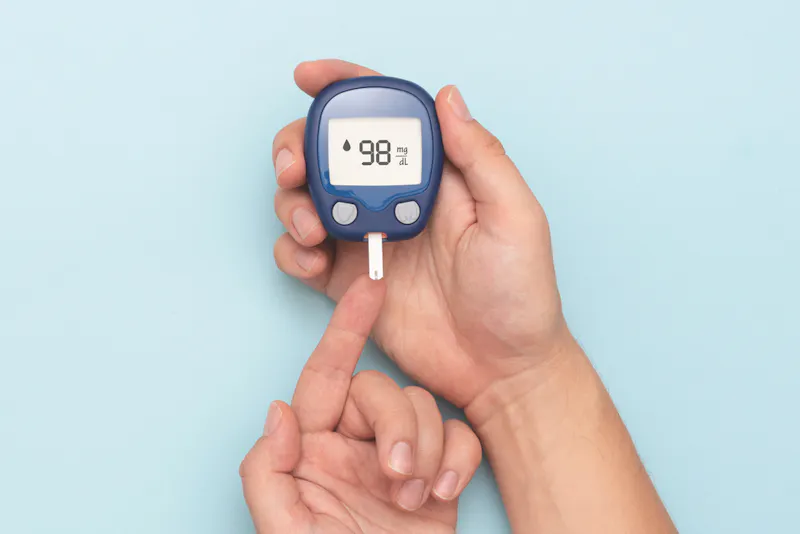What is type 2 diabetes?



Type 2 diabetes is a very common condition — 90% of people who have been diagnosed with diabetes have type 2. It was estimated in 2017 that approximately 415 million adults were living with the condition worldwide. A healthy lifestyle and eating a balanced diet can help lower your risk of type 2 diabetes.
What is type 2 diabetes?
Diabetes is a metabolic disorder that causes the level of sugar (glucose) in your blood to become too high — resulting in high blood sugar (hyperglycaemia).
Type 2 diabetes happens when one or both of the following occur:
- your pancreas doesn’t produce enough insulin for your body’s needs — a hormone that moves sugar into your cells
- your cells don’t respond properly to insulin — this is known as insulin resistance
This is different to type 1 diabetes, where your immune system attacks your healthy pancreas cells (usually from childhood), resulting in absolute insulin deficiency.
Type 2 diabetes tends to occur later in life and is usually caused by lifestyle factors. It's also linked to other conditions like polycystic ovary syndrome.
Type 2 diabetes tends to develop in adults, but children who are obese can also develop it — as carrying excess weight is a big risk factor.
You can check your blood sugar control over the last 3 months by using an HbA1c blood test.
What causes type 2 diabetes?
Type 2 diabetes is primarily caused by insulin resistance, as well as a combination of lifestyle and genetic risk factors.
The most common risk factors of type 2 diabetes include:
- carrying excess weight — the single greatest risk factor for developing this condition
- not getting enough exercise
- smoking
- having a family history of type 2 diabetes
- having gestational diabetes — a sugar intolerance that develops during pregnancy and puts you at risk of developing type 2 diabetes later in life
What are the symptoms of type 2 diabetes?
The symptoms of type 2 diabetes usually develop slowly — so many people can live with it for years and not know. The most common symptoms of include:
- extreme thirst
- urinating more often during the day and night
- extreme tiredness or fatigue
- slower healing cuts and wounds
- blurry vision
- increased infections
- unexplained weight loss
Getting a type 2 diabetes diagnosis
Getting a type 2 diabetes diagnosis usually involves talking through your symptoms with your GP, as well as a blood test to measure your blood sugar levels.
A range of blood tests can be used to help diagnose type 2 diabetes:
- HbA1c test — the main test used to diagnose type 2 diabetes which shows your average blood sugar levels over the last 2-3 months
- fasting plasma glucose test (FPG) — no food for 8 hours before the test
- random blood glucose test — usually done if your symptoms are severe and your doctor wants to confirm type 2 diabetes quickly
A test for type 2 diabetes might sometimes indicate if you’re at high risk of developing type 2 diabetes — this is called prediabetes. This happens when your HbA1c is raised but not raised enough to be diagnosed with type 2 diabetes.
Once diagnosed, type 2 diabetes is a lifelong condition. It was previously thought to be incurable, but evidence now exists that reversal is possible in some cases. Weight loss and keeping your blood sugar under control is the key. You can do this through lifestyle interventions, like low-calorie diets and low-carbohydrate diets that help minimise the risk of long term complications. In some cases, you need to take medication to help control your blood sugar.
Type 2 diabetes treatment options
Type 2 diabetes is a lifelong condition, so you’ll likely need to take long-term medication, change your eating habits, and regularly visit your doctor.
Medication
Medication is used in addition to lifestyle changes to manage type 2 diabetes. The most common treatment is a medication called metformin. It works by lowering your blood sugar levels to improve how your body responds to insulin. Metformin can be taken orally as a tablet or as a liquid that you drink.
Metformin isn’t suitable for everyone, but your GP will be able to talk through the different options to find the best medication for you.
Other medications used to treat type 2 diabetes include:
- meglitinides
- DPP-4 inhibitors
- GLP-1 receptor agonists
- SGLT2 inhibitors
Interestingly, there’s increasing evidence that it’s possible to reverse type 2 diabetes (when you reach and hold normal blood sugar levels without medication). Current research is looking into the different types of weight loss methods for reversing type 2 diabetes — mainly low-carbohydrate or very low-calorie diets.
Other low-calorie eating patterns that can help with weight loss and blood sugar control include:
- Mediterranean diet
- low-fat diet — based on foods like whole grains, vegetables, chicken, white fish, yoghurt, cheese, and fruits
- vegan or plant-based diet
- vegetarian diet
A low-carb diet
Eating a balanced and low-carb diet can help manage type 2 diabetes. A low-carb diet equates to eating less than 130 grams of carbohydrates a day. A poorly-planned, low-carbohydrate diet can be low in important nutrients — like fibre and essential vitamins. So you should never try this without the support of a dietitian.
A healthy low-carb diet includes:
- non-starchy vegetables — like carrots, broccoli, peppers, and tomatoes
- meat — like chicken and pork
- fish — like salmon and trout
- dairy products — like butter, cheese, and greek yoghurt
- eggs
- avocados
- olives
You should also speak to your GP for advice if you’re taking medication for type 2 diabetes and thinking about changing your diet.
Intermittent fasting
If you’re insulin resistant or have prediabetes or type 2 diabetes, you could try intermittent fasting — alternating between periods of fasting and periods of eating. There are several ways to do this, so it’s important to research this method of eating first and speak with a health professional.
Exercise
Exercise improves how your body uses insulin, can help lower HbA1c levels, and aid weight loss. This is because exercise allows your cells to use the blood sugar for energy, helping to reduce levels in the blood.
If you’ve been diagnosed with type 2 diabetes, opt for aerobic exercises that place less strain on your joints.
Some aerobic exercises include:
- swimming
- walking
- hiking
- rowing
Aim for 30 minutes of exercise at least 3 times a week.
If you don’t exercise regularly, it’s a good idea to start with 10 minutes a day for a week or 2 — then slowly build from there. When you feel you can do more, that’s the time to do more. Try not to overwork yourself and, most important of all, keep a positive mindset.
Other changes you should consider making if you have type 2 diabetes are:
- not smoking
- limiting your alcohol intake
Weight loss surgery
Weight loss surgery (bariatric surgery) can be an alternative option, particularly if your weight interferes with other functions like breathing.
Bariatric surgery is usually only considered for those who are most at risk and very overweight. In most cases, it’s only considered when other interventions have failed to work.
Type 2 diabetes can be a serious condition, especially if it’s not managed. If you have any of these symptoms, it’s important to see your GP to rule it out. Usually, medication like metformin or insulin therapy is required to help control your blood sugar levels.
Over time, type 2 diabetes can also increase your risk of:
- heart disease
- stroke
- kidney disease
- diabetic retinopathy — when high blood sugar levels damage the back of your eye (retina)
- nerve damage
Getting an early diagnosis and managing the condition will reduce the risk of these developing.
How to prevent type 2 diabetes
There are many things you can do to reduce your risk of developing type 2 diabetes. While not every case of type 2 diabetes is caused by excess weight, it’s the single greatest risk factor for developing the condition. So lifestyle factors to support a healthy weight tend to be the most beneficial.
Eat a healthy diet
Eat a healthy diet full of whole grains, fruits, vegetables, oily fish, nuts and seeds.
In particular, a diet high in whole grains (3 servings a day) might lower your risk of developing type 2 diabetes by as much as 30%. Whole grains include things like wheat, brown rice, oats, quinoa, and barley.
Whole grains also have a low glycaemic index (GI). This means they’re slowly digested and stop your blood sugar levels from rising and falling quickly (which can happen with refined grains).
Studies show that eating one and a half extra servings of green leafy vegetables a day reduces your risk of developing type 2 diabetes by 14 per cent.
Avoid having too many ultra-processed and sugary foods.
Track your waist size
A healthy waistline is a good indicator of whether or not you’re at risk of diabetes. Males should aim to be under 94cm (37ins) and females under 80cm (31.5ins).
Exercise regularly
Exercise is one of the most effective ways to reduce insulin resistance and can help you to maintain a healthy weight.
Aune, D., Keum, N., Giovannucci, E., Fadnes, L. T., Boffetta, P., Greenwood, D. C., ... & Norat, T. (2016). Whole grain consumption and risk of cardiovascular disease, cancer, and all cause and cause specific mortality: Systematic review and dose-response meta-analysis of prospective studies. BMJ, 353, i2716.
Ahren, B. (2007). DPP-4 inhibitors. Best Practice & Research Clinical Endocrinology & Metabolism, 21(4), 517-533.
Carter, P.. (2012). Dietary Prevention of Type 2 Diabetes: The Role of Fruit and Vegetable Intake (Version 1). University of Leicester. https://hdl.handle.net/2381/27617
Chatterjee, S., Khunti, K., & Davies, M. J. (2017). Type 2 diabetes. The lancet, 389(10085), 2239-2251.
Diabetes UK (2018). Treating your diabetes: Diabetes remission. Retrieved 24 July 2020 from https://www.diabetes.org.uk/guide-to-diabetes/managing-your-diabetes/treating-your-diabetes/type2-diabetes-remission.
Evert, A. B.,Dennison, M., Gardner, C.D., Garvey, W.T., Lau, K.H.K., MacLeod, J., Mitri, J., Pereira, R.F., Rawlings, K., Robinson, S., Saslow, L., Uelmen, S., Urbanski, P.B., Yancy, W.S. Nutrition Therapy for Adults With Diabetes or Prediabetes: A Consensus Report. Diabetes Care May 2019, 42 (5) 731-754; DOI: 10.2337/dci19-0014
Grant, J. S., & Graven, L. J. (2016). Progressing from metformin to sulfonylureas or meglitinides. Workplace health & safety, 64(9), 433-439.
Hundal, R. S., Krssak, M., Dufour, S., Laurent, D., Lebon, V., Chandramouli, V., ... & Shulman, G. I. (2000). Mechanism by which metformin reduces glucose production in type 2 diabetes. Diabetes, 49(12), 2063-2069.
Lean, M. E., Leslie, W. S., Barnes, A. C., Brosnahan, N., Thom, G., McCombie, L., ... & Rodrigues, A. M. (2018). Primary care-led weight management for remission of type 2 diabetes (DiRECT): an open-label, cluster-randomised trial. The Lancet, 391(10120), 541-551.
Nauck, M. A. (2014). Update on developments with SGLT2 inhibitors in the management of type 2 diabetes.Drug design, development and therapy,8, 1335.
Prasad-Reddy, L., & Isaacs, D. (2015). A clinical review of GLP-1 receptor agonists: efficacy and safety in diabetes and beyond.Drugs in context,4.
National Health Services (2020). Getting diagnoses. Retrieved 13 October 2021 from https://www.nhs.uk/conditions/type-2-diabetes/getting-diagnosed/.
National Health Services (2020). Type 2 diabetes. Retrieved 13 October 2021 from https://www.nhs.uk/conditions/type-2-diabetes/.